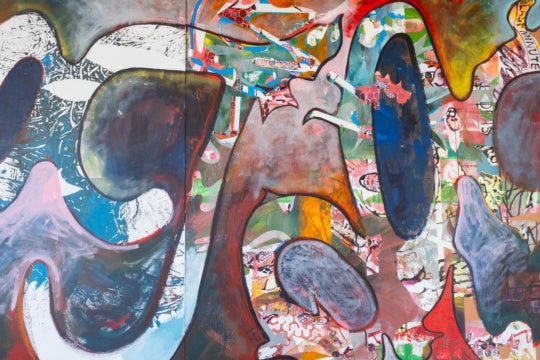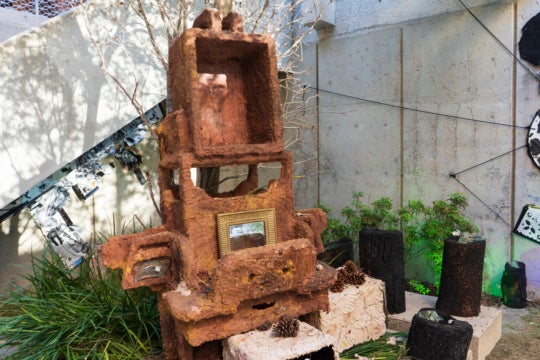Last week we were excited by the news that the decade-and-a-half-old Young Blood Boutique had been purchased by longtime employee Rebecca Hanna, MINT Director Erica Jamison, and supporter Jessie White. News of the sale followed an announcement that Young Blood would close at the beginning of 2013.
When the gallery started in the living room of then-roommates Kelly Teasley and Maggie White in 1997, Young Blood became the first space in Atlanta to focus on emerging artists tied to the DIY movement, skate art, and graffiti art. Fifteen years later the gallery and boutique are among good company in Atlanta as their founders pass the torch. Recently I communicated with founders White and Teasley, and with new owners Hanna and Jamison, to discuss the history of the space and the new owners’ plans for the future.
BURNAWAY: First of all, congratulations to you all on the new transition for the space. I know I speak for a lot of people in my excitement and relief that Young Blood is continuing. As I was growing up in Atlanta, Young Blood was the first gallery I ever went to during high school, and it’s been great to grow with the program and watch the space develop and transition over the years. The space has been a jumping-off point for so many artists that now have thriving art careers both in and outside Atlanta.
Maggie White: There’s a “mission accomplished” feeling. What we intended to do from the beginning was to give [exposure to] artists [who] didn’t have a place to show their work … back then. Fifteen years later, to hear that so many people have cited us as where they got their start is great.
Ben Venom was our first and one of our most beloved interns, and we’re really proud to see his recent success. He’s an example of us becoming a community, because we all stuck together. In a lot of cities galleries work with artists and then [the relationship is] done. When we work with artists we become close friends and [remain] friends with them … . There are a lot of individual relationships … we have formed that are examples of the community we were fortunate to be a part of. Unlike other cities [Atlanta] didn’t have a thriving arts scene so we really clung to each other. We really value each other.
BA: Rebecca, in thinking about your new role … after having been a longtime employee of the boutique, what are your plans as far as continuing this tradition within the space? How will the transition of MINT Gallery moving into the space adjust the way that things have run to date?
Rebecca Hanna: We want to work together. On a daily basis the spaces will be operated very separately, but we’re working on ideas for joint projects. We are so engulfed in the transition that we haven’t sat down and started talking specifics yet. We want to do community events and group readings, keeping both spaces together.
BA: Maggie and Kelly, only the boutique was sold in your agreement. As you move on to other projects, Young Blood Gallery is still your business. Do you have any plans for the gallery at this point?
Kelly Teasley: We have talked about some planned shows we had to cancel that we are still interested in [presenting]. We are talking about going back to our roots and doing one-night pop-up shows in houses and spaces that are not necessarily galleries.
MW: Nothing is on the calendar yet. Atlanta has plenty of alternative spaces that could host an art show. To be honest it’s hard for galleries to sustain the expense of a month-long show when most attendees just come out for opening night.
BA: How does it feel to be passing on the boutique to new hands? You started that business form before Handmade Nation and Etsy were trendy … . Young Blood brought that model to Atlanta … .
MW: It’s an absolute win for the community. The timing worked out pretty amazingly, because it was so last minute and [because of] the way it came together … . Combining MINT and their community programming with the boutique is a winning [formula]. The boutique is founded on a community-based mission. It was a form of activism when we started it. We wanted to stand up to the corporate commercialism in Atlanta. You didn’t have many shops where you could find independent artists. We wanted to offer an alternative. It’s a powerful thing when a consumer can deal with a shop owner … . It’s important to a community as a whole and teaches community responsibility and the responsibility of knowing what you are buying … instead of buying something completely disconnected from your … world. We wanted to provide a community service.
RH: It [was] interesting to hear people’s reactions earlier this week. A girl at San Francisco Coffee [a business adjacent to Young Blood] was saying she was so excited because she felt like it was the only place that understood what she wanted and that spoke to the people that live in the community. It’s so amazing to hear someone reaffirm that feeling that we all feel.
MW: Going back to the gallery, I think it will be a huge change for MINT [to be] available every day and for people walking around. It will open … a lot of opportunities.
BA: Erica, tell me about the impact this move will have on MINT.
Erica Jamison: Well, the main reason [we are moving] is the rising rent cost. Our current space is on the [Atlanta] BeltLine. Our landlord has been very supportive over the years, but at some point he had to raise the rent. Personally I’d been feeling very bogged down with our current space, so in some ways it was a blessing to be able to find something that fits our programming and budget because I want to do a lot of work that is not exhibition-based.
BA: So how did the opportunity come up?
EJ: Well, I’d actually been talking with another group of people about purchasing Young Blood as a whole, including the gallery space, then [I] met … with Rebecca and Jessie and found out they were both interested. Then my original group kind of fizzled … but I was still really excited by the idea. At first I thought I’d … basically be doing two galleries, but then Kelly and Maggie decided they wanted to keep the gallery side to do pop-up shows.
Rebecca, Jessie, and I all agreed that we were more interested in the boutique. We were playing around with how to make the space work—making the boutique larger, only renting out the front, and the idea to move mint just popped [into] my head.
BA: So, will this allow MINT to expand its program or mission in any way?
EJ: Absolutely. It is lowering our financial overhead slightly while providing us some much-needed staff support. We’ve got a lot of programming that I’ve put on the back burner because I’ve been so busy with the day to day.
Young Blood Boutique and MINT Gallery will have a grand opening February 2.





